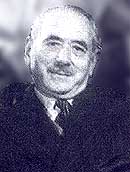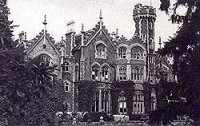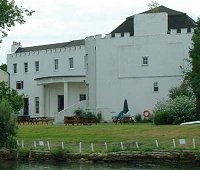 Enrique
Carreras, shown on the right, moved to England and opened up his first cinema
in Hammersmith, London in 1913. The theatre, named the Blue Halls, seated
2000 people and was divided into two theatres, each showing different movies.
This theatre is considered by many to be the first multi-plex. Carreras expanded
his company into a chain of theatres. In 1928, he formed Exclusive Films to
serve as a distribution company.
Enrique
Carreras, shown on the right, moved to England and opened up his first cinema
in Hammersmith, London in 1913. The theatre, named the Blue Halls, seated
2000 people and was divided into two theatres, each showing different movies.
This theatre is considered by many to be the first multi-plex. Carreras expanded
his company into a chain of theatres. In 1928, he formed Exclusive Films to
serve as a distribution company.
In the early 1930's, jewelry shop owner Williams Hinds
was traveling through England, appearing as Will Hammer in an amateur vaudeville
act billed as Hammer And Smith.
Carreras and Hinds met and formed a partnership in 1932,
securing the distribution rights to several British Lion pictures. Hinds
formed Hammer Productions in November 1934. In 1935, they changed the name
of their distribution company to Exclusive Films Ltd.
Following the short-subject film Polly's Two Fathers,
Hammer Productions released it first feature film in 1935, The Public
Life of Henry the Ninth. Over the next few years, numerous
short subject and feature films were released to mediocre success, but by
1939 production halted and Hammer became inactive.
Enrique's son, James Carreras joined the Exclusive
team in 1939. William's son, Anthony Hinds, also joined the studio in 1939,
however both were called into active service during the World War II before
returning to work for Exclusive in London, in 1945.
Exclusive continued to distribute films
and, because of the close links between the two companies, many films around
this era are incorrectly labeled as Hammer films.
With a growing demand for British-produced movies after
the war, Hammer was re-formed in 1947 as a production subsidiary of Exclusive.
The first production from the new Hammer was 'River Patrol' in 1948.
In February of 1949, Hammer was registered as a separate
company, Hammer Film Productions Limited, with a logo of a blacksmith striking
an anvil. The first 'official' film released by the newly formed Hammer was
Dr Morelle - The Case of the Missing Heiress, released by Exclusive
on June 27, 1949.
By 1950, Exclusive/Hammer was producing a steady supply
of support drama and documentaries, largely inspired by the needs of the group's
chain of cinemas. Things changed when Hammer began co-producing its films
with American film producer Robert Lippert in 1951. This partnership enabled
Hammer to develop its North American market, and cast American stars. The
company's first color feature film was The Men of Sherwood Forest,
released in 1954.
20th Century-Fox bought Lippert in 1955. That same
year, Hammer released the immensely successful The Quatermass Xperiment,
re-titled The Creeping Unknown for the United States and caused Hammer
to focus on horror films. Hammer then brought together the 4 people that would
forge the new direction of Hammer films; director Terence Fisher, script writer
Jimmy Sangster, and acting legends Peter Cushing and Christopher Lee.

Hammer Films were normally filmed outside the studios in country houses, such
as the private mansion shown on the left called Oakley Court.
In 1957, while filming at Oakley Court, the company
became interested in filming in the neighboring mansion
called Down Place.
Down Place, shown on the right, was located next to
the River Thames near Windsor. They purchased the mansion as a  permanent
home for their studio and called it Bray Studios.
permanent
home for their studio and called it Bray Studios.
With the global success of their films, Hammer started
to work with major American distributors like 20th Century Fox, Columbia Pictures
and Warner Brothers.
The move towards American distributors eventually led
to the closing of Exclusive in 1968.
Michael Carreras left in 1961 to form his own company,
Capricorn Films, but continued to produce films for Hammer.
By the mid 1960's, a new financial deal with Seven Arts,
20th Century Fox, and ABPC allowed another burst of gothic films, but also
included a mix of film genres, such as She and
One Million Years BC and a series of 'Hitchcock-style' thrillers.
In 1971, Michael Carreras rejoined Hammer but the film
industry was on the decline primarily due to television. The
company's formula for horror films was becoming tired. The company began to
seek novel ways to spice up its output with a series of highly charged vampire
stories steeped in eroticism and nudity, as well as a touch of lesbianism.
The first film, Vampire Lovers, featured Ingrid
Pitt as the bisexual vampire. Pitt returned for Hammer's Countess Dracula."
At the same time, the company discovered a lucrative side-line in spin-offs
of British TV sit-coms.
The mid 1970s brought US films like The Exorcist
and Rosemary's Baby, Hammer was slowly taking the backseat
in the horror genre. James Carraras retired and Michael took over. Carreras
tried to get new films off the ground, like Vampirella, but the game
was up, gothic horror was out of fashion, and Hammer couldn't find backers
for production, To the Devil a Daughter, the company's last horror
film.
In the 1980's, Hammer Films turned their attention to
television and introduced the Hammer House of Horror. Unfortunately,
their venture into television was short-lived and the company closed.
Between 1935 and 1983, the company released more than
250 films and television productions.
THE PHOENIX RISES
Out of the ashes ....
In August of 2003, it was announced that Hammer Films
and Chris Brown's Pictures in Paradise (PiP) have joined forces to develop
a slate of low-budget horror movies. The plan is to deliver a slate of up
to six horror movies over a period of five years. The films will be targeted
at the young cinema-going audience and will be designed to have strong potential
in other media, especially DVD.
For more information on Hammer Films, its history and
its future, be sure to visit their official website at http://www.hammerfilms.com/.
Here's the Hammer
Films that we have in our database so far.
Universal Studios distributed an a group of Hammer
Films



